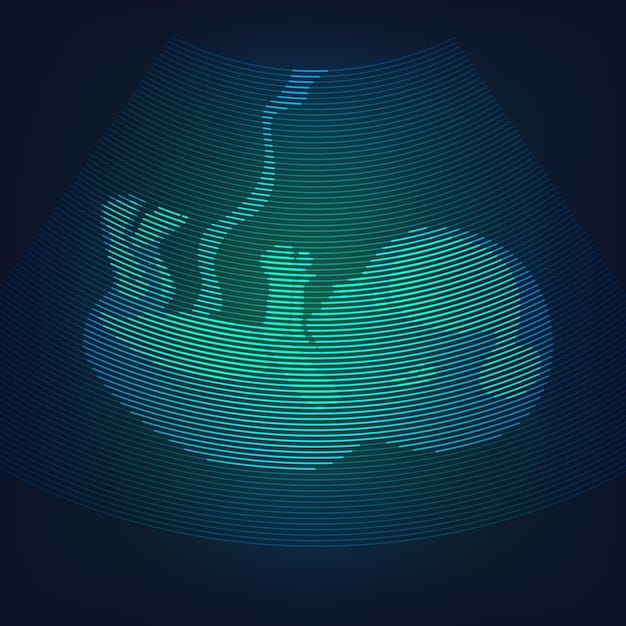Infant Reflux: Understanding & Practical Solutions for a Happier Baby

Understanding infant reflux involves recognizing symptoms like frequent spit-up and implementing practical strategies such as modifying feeding techniques and keeping the baby upright after meals to minimize discomfort and promote a happier, healthier baby.
Is your little one experiencing frequent spit-up and discomfort? Understanding infant reflux is the first step towards finding effective solutions for a happier, more comfortable baby. Let’s explore practical strategies and tips to manage and alleviate infant reflux.
Understanding infant reflux: what you need to know
Infant reflux, also known as gastroesophageal reflux (GER), is a common condition in babies. It occurs when stomach contents flow back up into the esophagus. While it can be distressing to witness, it’s often a normal physiological process that resolves on its own as the baby matures.
It’s essential to differentiate between normal reflux and gastroesophageal reflux disease (GERD), which is a more severe form that can cause complications.
What causes infant reflux?
Several factors contribute to infant reflux. A primary one is the immaturity of the lower esophageal sphincter (LES), the muscle that acts as a valve between the esophagus and the stomach. In infants, this sphincter may not be fully developed, allowing stomach contents to flow back up more easily.
Other contributing factors include:
- Overfeeding: Feeding the baby too much at once can overwhelm the stomach and increase the likelihood of reflux.
- Lying down after feeding: Gravity helps keep stomach contents down, so lying flat after a meal can exacerbate reflux.
- Certain foods in the mother’s diet (if breastfeeding): Some foods, like caffeine and spicy dishes, can pass through breast milk and potentially irritate the baby’s digestive system.
It’s crucial to consult with your pediatrician if you have concerns about your baby’s reflux. They can help determine the underlying cause and recommend appropriate management strategies.
Understanding the causes of infant reflux empowers parents to make informed decisions about feeding practices and other interventions that can help alleviate symptoms.

Recognizing the symptoms of infant reflux
The symptoms of infant reflux can vary from baby to baby. While some infants may only experience occasional spit-up, others might exhibit more pronounced signs of discomfort.
Being able to recognize these symptoms early on can help you provide timely care and support for your little one.
Common signs of infant reflux
Here are some of the most common symptoms associated with infant reflux:
- Frequent spit-up or vomiting: This is often the hallmark sign of reflux. It can range from small amounts of spit-up to more forceful vomiting.
- Irritability or fussiness, especially after feeding: Reflux can cause discomfort or pain, leading to increased fussiness in babies.
- Arching of the back during or after feeding: This can be a sign that the baby is trying to relieve discomfort in their esophagus.
- Poor weight gain or weight loss: In severe cases, reflux can interfere with a baby’s ability to gain weight properly.
Remember, not all babies who spit up have reflux. Occasional spit-up is normal, especially in the first few months of life. However, if you’re concerned about the frequency or severity of your baby’s symptoms, it’s always best to seek professional medical advice.
By recognizing the different symptoms of infant reflux, parents can better understand their baby’s needs and work towards implementing practical solutions.
Practical feeding techniques to reduce reflux
One of the most effective ways to manage infant reflux is through careful attention to feeding techniques. Simple adjustments to how you feed your baby can make a significant difference in reducing symptoms.
These adjustments can ease the reflux and promote comfortable digestion.
Tips for effective feeding practices
Consider these strategies to help reduce reflux during feeding:
- Feed your baby in an upright position: Holding your baby upright during feeding helps gravity keep stomach contents down.
- Burp your baby frequently during and after feeding: Burping helps release trapped air in the stomach, which can contribute to reflux.
- Avoid overfeeding your baby: Feeding smaller amounts more frequently can prevent the stomach from becoming overly full, reducing the chance of reflux.
- Keep your baby upright for at least 20-30 minutes after feeding: Again, gravity is your ally. Keeping your baby upright allows the stomach to empty more effectively.
For bottle-fed babies, consider using a slow-flow nipple to prevent them from gulping down too much milk too quickly. If you are breastfeeding, ensure a proper latch to minimize air intake.
Implementing these feeding techniques can significantly reduce infant reflux symptoms and improve your baby’s overall comfort.
Dietary considerations for breastfed and formula-fed babies
For both breastfed and formula-fed babies, dietary adjustments can play a role in managing reflux symptoms. Different approaches may be appropriate depending on how your baby is fed.
Knowing which adjustments to make can help ease your baby’s symptoms.
Advice for breastfeeding mothers
If you’re breastfeeding, consider these dietary adjustments:
Eliminate potential irritants: Some babies are sensitive to certain foods in their mother’s diet. Common culprits include dairy, caffeine, spicy foods, and acidic fruits like citrus. Try eliminating these foods one at a time to see if it makes a difference.
It’s best to do this under the guidance of a healthcare professional or lactation consultant to ensure you’re still meeting your nutritional needs.
Choosing the right formula
For formula-fed babies, consider these options:
- Thickened formulas: These formulas are specially designed to be thicker than regular formula, which can help reduce reflux.
- Hydrolyzed formulas: These formulas contain proteins that have been broken down, making them easier to digest. This can be helpful for babies with sensitivities.
- Non-dairy formulas: If your baby has a cow’s milk protein allergy, a non-dairy formula may be necessary.
Always consult your pediatrician before making any changes to your baby’s formula. They can help you choose the right option based on your baby’s individual needs.
Making informed dietary choices can have a positive impact on reducing reflux symptoms in both breastfed and formula-fed babies.

Lifestyle adjustments to minimize reflux
Beyond feeding techniques and dietary considerations, certain lifestyle adjustments can also help minimize infant reflux symptoms. Creating an environment that supports comfortable digestion can make a significant difference.
These simple changes can bring comfort to your little one.
Practical lifestyle tips
Consider these adjustments to help reduce reflux:
Elevate the head of the crib or bassinet: By raising the head of your baby’s sleeping surface, you can help gravity keep stomach contents down. Use a wedge under the mattress rather than propping the baby up with pillows, which can be unsafe.
Avoid tight-fitting clothing: Tight clothing can put pressure on the stomach, increasing the likelihood of reflux.
Gentle handling after feeding: Avoid vigorous activity or bouncing your baby immediately after feeding. Give their digestive system time to settle.
Consider babywearing: Keeping your baby in an upright carrier after feeding can help reduce reflux symptoms. However, ensure the carrier is properly fitted and supports your baby’s hips and spine appropriately.
By incorporating these lifestyle adjustments into your daily routine, you can create a more comfortable environment for your baby and help minimize reflux symptoms.
When to seek medical advice for infant reflux
While infant reflux is often a normal physiological process, there are times when it warrants medical attention. Recognizing when to seek professional help is essential for ensuring your baby receives the care they need.
It’s always best to err on the side of caution when it comes to your baby’s health.
Warning signs to watch out for
Consult your pediatrician if you notice any of the following:
- Forceful or projectile vomiting: This could be a sign of pyloric stenosis, a condition where the muscle at the outlet of the stomach thickens, preventing the stomach from emptying properly.
- Bloody or green vomit: This could indicate a more serious underlying issue, such as a bowel obstruction or bleeding in the digestive tract.
- Refusal to feed or poor weight gain: If reflux is interfering with your baby’s ability to eat and gain weight, it’s important to seek medical attention.
- Respiratory problems, such as coughing, wheezing, or difficulty breathing: Reflux can sometimes lead to aspiration, where stomach contents enter the lungs.
Even if your baby’s symptoms don’t fall into these categories, it’s always a good idea to talk to your pediatrician if you have any concerns about their reflux. They can assess your baby’s individual situation and recommend the best course of action.
Knowing when to seek medical advice for infant reflux ensures that your baby receives timely and appropriate care, promoting their health and well-being.
| Key Point | Brief Description |
|---|---|
| 👶 Upright Feeding | Hold baby upright to help gravity keep stomach contents down. |
| 🍼 Smaller Feeds | Feed smaller amounts more frequently to prevent overfilling. |
| 🌙 Elevate Crib | Elevate the head of the crib to aid digestion during sleep. |
| 👩⚕️ Seek Advice | Consult a doctor for forceful vomiting or poor weight gain. |
[Frequently Asked Questions]
▼
Main symptoms include frequent spit-up, fussiness after feeding, arching of the back, and, in severe cases, poor weight gain. Occasional spit-up is normal, but persistent symptoms should be checked.
▼
Feed your baby in an upright position, burp them frequently, avoid overfeeding, and keep them upright for 20-30 minutes after feeding. These techniques help reduce the likelihood of reflux.
▼
Breastfeeding mothers can try eliminating potential irritants like dairy, caffeine, and spicy foods. Monitor your baby’s symptoms to see if these changes make a difference in their comfort.
▼
Seek medical advice if you notice forceful vomiting, blood in vomit, refusal to feed, poor weight gain, or any respiratory problems. These could indicate a more serious issue.
▼
Yes, elevate the head of the crib, avoid tight-fitting clothing, handle your baby gently after feeding, and consider babywearing. These adjustments can create a more comfortable environment.
Conclusion
Understanding infant reflux and implementing practical solutions can significantly improve your baby’s comfort and well-being. By paying attention to feeding techniques, dietary adjustments, and lifestyle changes, you can effectively manage reflux symptoms and ensure your little one thrives. Remember to consult with your pediatrician if you have any concerns, and trust your instincts as you navigate this common challenge in early parenthood.





